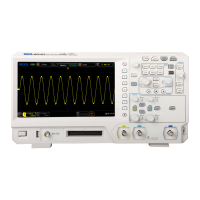RIGOL Chapter 18 Store and Load
18-2 MSO5000-E User Guide
Storage System
Press Storage on the front panel to enter the store and load setting interface. It
provides one USB HOST interface on the front panel, which can all be connected to
the USB storage device for external storage. The USB storage devices connected are
marked as "Removable USB Disk(D)", "Removable USB Disk(E)", "Removable USB
Disk(F)", and "Removable USB Disk(G)", respectively.
Storage Type
The file types for storage include image, waveform, and setups. The storage
descriptions of each type are as follows.
1. Image
Press Save Image → Format, and then use the multifunction knob to
select the image type. You can also press Format continuously or enable the
touch screen to select it. Save the screen image to the internal or external
memory in "*.png", "*.bmp", "*.jpg", or "*.tif" format.
After selecting this type:
➢ Press File Name to input the file name to be saved. For filename input,
refer to descriptions in "To Create a Folder". Press Storage → More →
Auto Name to select "ON", then the filename is generated automatically. If
the filename that you input is the same as the existing filename, a prompt
message will be displayed, reminding you that the existing file will be
overwritten and asking you whether to continue or not.
➢ Press Invert to enable or disable the invert function.
➢ Press Color to select the desired storage color. It can be set to "Gray" or
"Color".
➢ Press NewFolder to create a new storage folder. For details, refer to
descriptions in "To Create a Folder".
➢ Press Window to display or hide the disk management interface.
➢ Press Save to save the set image file. Press Storage → More → Header
to select "ON" or "OFF". If you select "ON", the instrument model, firmware
version number, serial number, and the image creation date will be
displayed in the header of the image when you save the image file.
Tip
After a USB storage device (FAT32 format, flash memory) is connected, press
Quick on the front panel to save the file. You can select to save to the internal
memory or the external USB storage device. When a USB storage device is not
connected, the file is, by default, saved to the internal memory. When a USB
storage device is connected, the file is saved to the external storage device
automatically.

